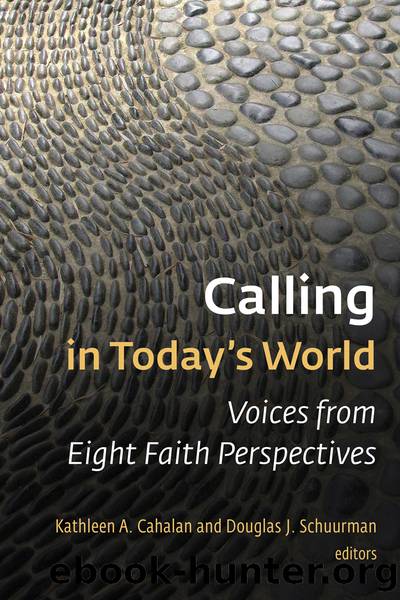Calling in Today's World by Cahalan Kathleen A.;Schuurman Douglas J.;

Author:Cahalan, Kathleen A.;Schuurman, Douglas J.;
Language: eng
Format: epub
Publisher: Wm. B. Eerdmans Publishing Co.
Published: 2016-06-27T15:18:16+00:00
Living Out a Calling: The Unity of Life and Callings as Worship
With its emphasis on the interdependent character of existence and the fulfillment of obligations, it is no surprise that the Hindu tradition likens the universe to a cosmic person. The Puruá¹£asÅ«kta hymn of the á¹g Veda (10:90) describes the universe as emerging from the body of the cosmic person and equates various elements in nature (sun, moon, air, earth) with specific parts of the cosmic body.24 The underlying purpose of the metaphor is to highlight the unity and interdependent functioning of the world. A healthy human body is one in which each organ serves the whole in accordance with its unique character. The proper functioning of the whole, in turn, nourishes each organ.25 If an organ does not contribute to the functioning of the body, like a thief in the example of the BhagavadgÄ«tÄ (3:12), the body is hurt, but also the organ. The human body is a model of the harmony of svabhÄva and svadharma, since each organ serves the body (svadharma) through the expression of its uniqueness (svabhÄva). The realization of our individual potential is important not only for our personal fulfillment but also for the common good. The community is diminished when, for whatever reason, a human being fails to realize her worth and potential. It is imperative, therefore, that communities promote values and opportunities that enable human self-Âfulfillment in terms of both svabhÄva and svadharma.
Although a concern for the common good does not have to be connected with a religious worldview, the BhagavadgÄ«tÄ and most Hindu traditions certainly assume this connection. SvabhÄva and svadharma have religious meaning, and this meaning informs how these are lived out in various contexts and roles.
At the heart of this religious meaning is a theology of all work as worship, enunciated throughout the BhagavadgÄ«tÄ. According to the BhagavadgÄ«tÄ (18:46), âA human being attains lifeâs highest purpose by worshipping with his own work (svakarmaá¹Ä), the One from whom all beings originate and who exists in all.â26 The text (9:27) commends the offering of all actions to God in worship. âWhatever you do, whatever you eat, whatever you offer in worship, whatever you give, do it as an offering to me.â27 In each phrase the word yat (whatever) is repeated. The intent of the text here is to unify human life by including all actions and activities and commending the performance of these as worship. Worshipful actions, it is important to remember, are not only the heroic actions of Arjuna in the BhagavadgÄ«tÄ or Mahatma Gandhi leading a freedom movement. Worshipful actions are also not limited to what is usually described as work. All actions are included and the value of every action is enhanced and sanctified when it is performed as an offering to God.
In the BhagavadgÄ«tÄ, the essence of worship is an offering or an undertaking motivated by the love (bhakti) of God. In the verse (9:26) preceding the one cited above, Krishna identifies love of God as the affection that makes an action one of worship.
Download
This site does not store any files on its server. We only index and link to content provided by other sites. Please contact the content providers to delete copyright contents if any and email us, we'll remove relevant links or contents immediately.
Getting It, Then Getting Along by L. Reynolds Andiric(610)
Global Justice, Christology and Christian Ethics by Lisa Sowle Cahill(386)
Religion and Politics Beyond the Culture Wars : New Directions in a Divided America by Darren Dochuk(383)
Positive Psychology in Christian Perspective: Foundations, Concepts, and Applications by Charles Hackney(323)
Forgiveness and Christian Ethics by Unknown(307)
Douglas Hamp The First Six Days by Unknown(208)
Christian Martyrdom and Christian Violence by Matthew D. Lundberg;(201)
The Oxford Handbook of Greek and Roman Mythography by R. Scott Smith;Stephen M. Trzaskoma;(193)
The Bloomsbury Reader in Christian-Muslim Relations, 600-1500 by David Thomas;(186)
Beyond Heaven and Earth by Gabriel Levy(185)
God and Eros by Patterson Colin;Sweeney Conor;(185)
Insurgency, Counter-insurgency and Policing in Centre-West Mexico, 1926-1929 by Mark Lawrence(183)
The Horrors and Absurdities of Religion by Arthur Schopenhauer(177)
Autobiography, Volume 2: 1937-1960, Exile's Odyssey by Mircea Eliade(171)
Cult Trip by Anke Richter(171)
Witches: the history of a persecution by Nigel Cawthorne(168)
The Myth of Disenchantment by Jason A. Josephson-Storm(155)
An Introduction to Kierkegaard by Peter Vardy(153)
The Believer by Sarah Krasnostein(150)
